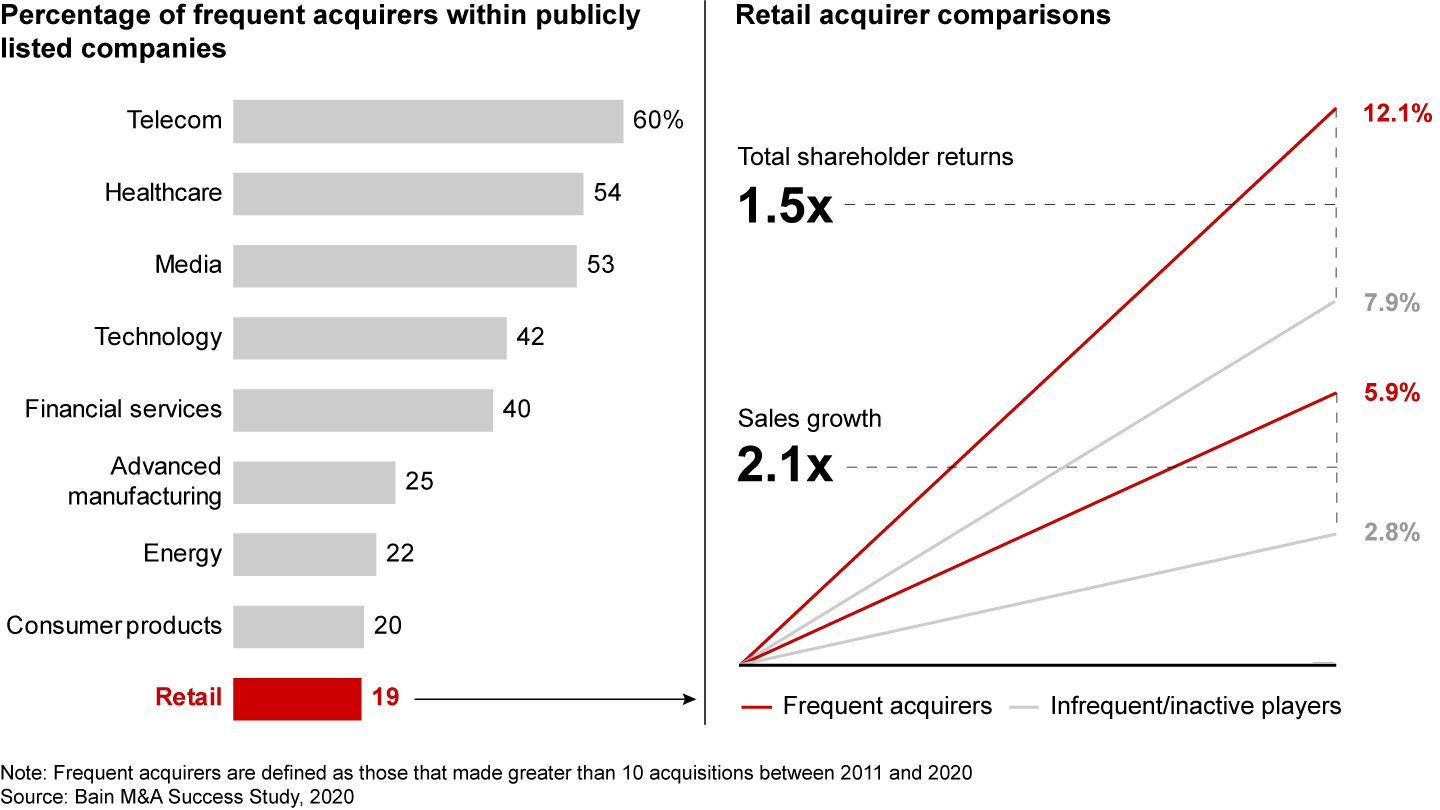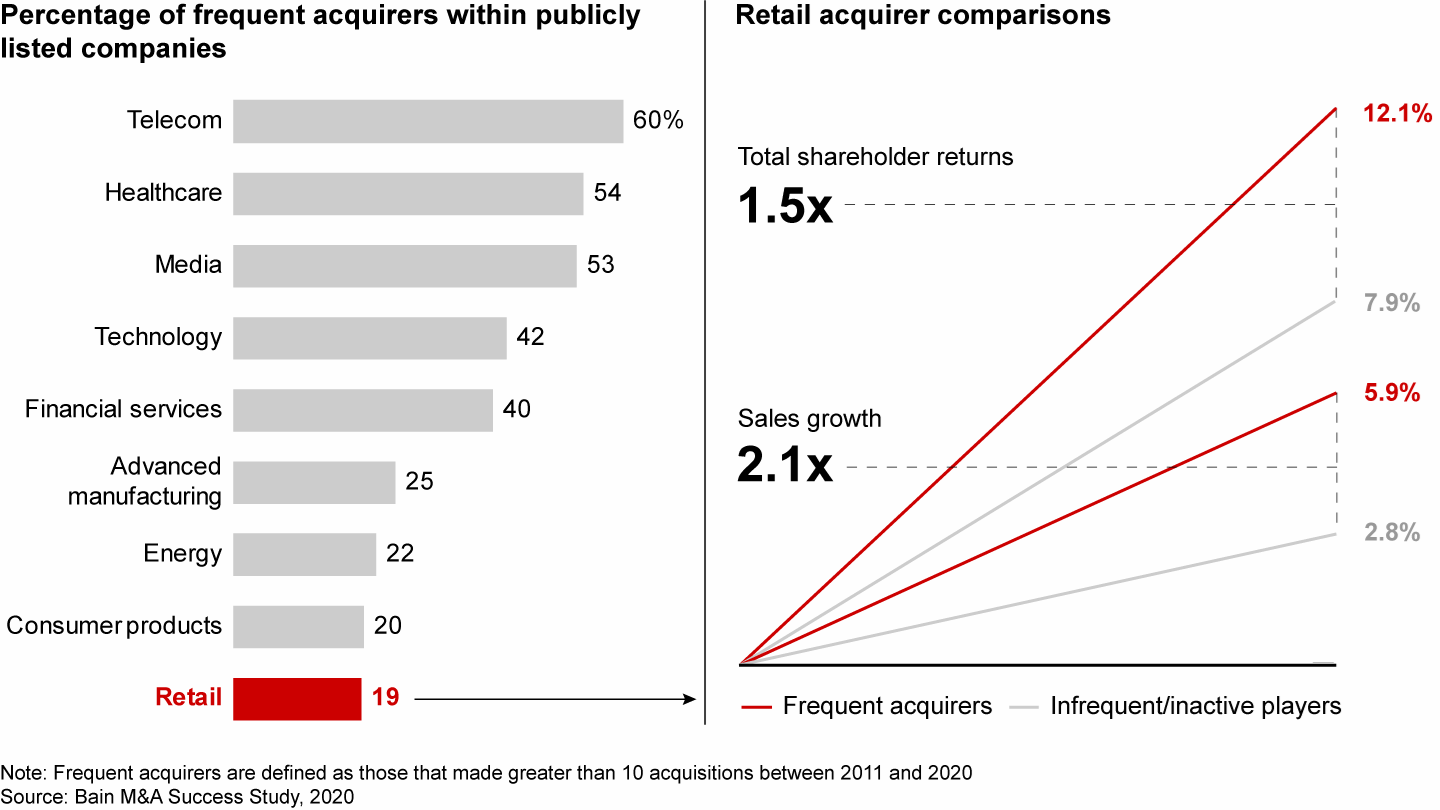M&A Report

At a Glance
- Consumer interest in rapid delivery of food, groceries, and other goods has risen dramatically since the beginning of pandemic lockdowns.
- Emerging quick-commerce players and incumbent retailers are both turning to M&A and partnerships to gain the capabilities needed to compete.
- Established retailers can help quick-commerce companies scale, and they can provide extensive existing customer bases and core retail capabilities, such as product assortment, that will attract and retain customers.
- Partnering with or acquiring quick-commerce companies provides incumbent retailers with hyperlocal delivery strength, established driver networks, and delivery logistics capabilities outside of the typical retail wheelhouse.
This article is part of Bain's 2022 M&A Report.
To see the future of retail, step into almost any elevator in China, where you’re likely to stand shoulder to shoulder with delivery folks bearing meals, groceries, personal care products, and virtually anything else you can think of that can be ordered online and transported on a scooter to your door in 30 minutes or less.
In China, where e-commerce penetration is around 30% in almost all categories—well ahead of the US and Europe—foot traffic to retail outlets is down 10% compared with pre-pandemic levels. Many believe that traffic is not coming back as consumers shift their buying behavior, opting for the super-fast delivery of goods in what is now being referred to as “quick commerce.” Meituan, China’s pioneer in quick commerce, makes an estimated 32 million express deliveries every day, relying on millions of drivers for around 670 million active users.
Now part of daily life in China, quick commerce is taking root in the rest of the world as consumers become accustomed to—and then demand—increasingly short delivery times for a widening array of purchases. To build out the businesses that will serve this market, funding for quick-commerce delivery providers is at record highs across the globe, with investments now coming in at a rate that is more than eight times the 2020 level.
As businesses iterate on operating models, consumer value propositions, and new strategies to serve the quick-commerce demand, many are finding that M&A is the fastest way to develop the capabilities they need to stay competitive. The year 2021 brought with it a flurry of deals and partnerships in quick commerce.
Doordash bought Finland-based delivery app Wolt for $8 billion to expand its global reach. Wolt contracts out couriers to deliver takeout, groceries, and other goods to customers in 23 countries mainly throughout Europe. Germany-based Delivery Hero acquired food and grocery delivery platform Hugo to expand into Central America. Boston-based Drizly and 7-Eleven teamed up to deliver alcohol in under an hour. Kroger and Ahold-Delhaize announced partnerships with Instacart that build out both grocers’ 30-minute delivery options. Meanwhile, Carrefour invested in Cajoo while Tesco and Gorillas partnered to offer 10-minute delivery in London.
As these deals get inked, traditional retailers and emerging quick-commerce companies both are looking for a path to scale economics. Undoubtedly, the economics are more attractive in dense urban settings, but quick commerce is beginning to reach suburban consumers, too. As long as the per-order economics are close to breakeven on average, scale players are likely to have a viable model in time, fueled by additional sources of value to fund the gap. This includes data monetization, ad sales on digital media, partner subsidies/vendor funding, and robust private label offerings—similar to the path that Amazon, Alibaba, and Instacart have taken.
While the economics are more attractive in dense urban settings, quick commerce is beginning to reach suburban consumers, too.
The pressure to provide retail customers with near-immediate convenience is here to stay and will expand across verticals and customers. Today’s model focuses on the urban, young, and affluent customer segments, not because of a lack of broader customer demand but because of limited supply. We’ve seen this story play out in retail before. Two-day shipping and online grocery delivery were originally targeted at much the same customer segments. Now they are table stakes, with broad appeal across geographies and customer segments.
For both the emerging class of quick-commerce players and existing retailers looking to evolve with changing customer expectations, M&A and partnership expansion should be at the top of the executive agenda.
For new entrants, growth means expanding geographically as fast as funding is available, optimizing assortments, and building a network of both couriers and customers. Winners will be those with a loyal fleet that can deliver (almost) anything to anyone at any time. Established retailers can help new entrants accelerate customer acquisitions and product-portfolio perfection, and they offer access to the benefits of scale and experience.
The link between M&A and corporate performance is especially strong in retail.
Meanwhile, traditional retailers can look to quick-commerce partners as the fastest path to establishing delivery capabilities that truly wow their customers. Partnering for or acquiring these services will provide hyperlocal delivery strength, with established courier networks and delivery logistics capabilities outside of the typical retail wheelhouse—not to mention access to the agility that these young companies bring to the table.
The link between M&A and corporate performance is especially strong in retail. Our research has found that retailers with a track record of frequent and material M&A significantly outperform infrequent or inactive buyers (see Figure 1 and “Bain’s Bedrock Beliefs on How to Create Value from M&A”).
One in five retail companies is a frequent acquirer, and these organizations see growth benefits as a result


The best companies use deals to test and learn in the early innings, positioning themselves for success as the market evolves. The institutional insights they gain will be critical as quick commerce expands across geographies and as the number of players rapidly multiplies. Not all quick-commerce providers will survive. We do expect meaningful consolidation, but we also see room for several players to win over time.
Winners in this new model will focus on three areas:
- Provide a differentiated offering. Leaders will find their niche and create their strategy around it. This can be assortment or private label. It can be price, quality, or reliability. Or it can be employee loyalty or customer personalization. Having a clear view and maintaining focus on the company’s sweet spot will be critical for success.
- Leverage data. As these new offerings evolve, companies that use their data to rapidly understand the changing environment will be best positioned to win. Strong performers will leverage data across multiple dimensions—customer facing, supplier facing, and logistics, for example. Data can help retailers locally tailor inventory and product offerings. It also can be sold to suppliers for an additional source of revenue. And data can be used to optimize routing, batching, and delivery economics.
- Accelerate M&A. As we mentioned, leaders will use M&A to find and integrate new capabilities, whether through outright acquisitions or alternative approaches such as minority investments and partnerships. This will require frequent and continuous dealmaking as the market swiftly evolves and grows. Retailers should plan for opportunities long before specific deals are on the table. That means aligning the logic for target screening, building a pipeline of priority targets with customized deal theses, and cultivating relationships with those high-potential targets.
The best companies use deals to test and learn in the early innings, positioning themselves for success as the market evolves.
Partnerships, in particular, will give incumbents speedy access to new capabilities while providing optionality in a world where many new disrupters are still emerging. Indeed, the long-term winners in quick commerce might not yet be in sight, but the best companies know that’s not a reason to delay entering the race.